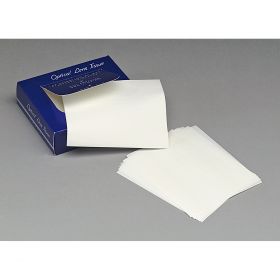There are three things which most research grade and laboratory microscopes share in common: (1) They are relatively expensive pieces of equipment, (2) They are delicate instruments with a complex series of components and (3) They don’t clean themselves!
One of the most important aspects of the use, care and maintenance of a microscope is keeping it clean. There’s the financial investment issue in the instrument as well as the time investment in preparing specimens and slides. The last thing you want is for dust and dirt to contaminate your images. Prevention is better than cleaning and the easiest way to keep a microscope clean is to use the dust cover when the instrument is not in use. If you don’t have a dust cover, you can always buy one, or even use a large thick bin liner or bag- anything which prevents dust from settling on the lenses.
It should be emphasised that improper cleaning of lenses and parts can cause as much (if not more) damage than leaving a neglected instrument. For example, tiny grit particles can cause scratching on the surface of lenses, cleaning solvents can affect coating on the lens surface and if too much solvent is used, this can lead to degradation of the cement which is used to hold objective front lenses in place.
If you can see dust/dirt/smudges or blurring when looking down the eyepieces, the first thing to do is locate the source of contamination. This can be done by checking each of the objectives in turn. If the contamination remains, then it is likely to be on the eyepieces/sub-stage condenser or field diaphragm. For routine cleaning, these are the only components which should be considered. Do not attempt to clean any of the internal optical components of a microscope unless you know exactly what you are doing! This is best left to a specialist as part of the maintenance contract, or to a knowledgeable microscope technician.
There are four items which you should invest in before tackling the cleaning of a microscope- an air duster, lens cleaning tissue, cotton buds (or ‘Q-tips’) and a lens cleaning solvent/solution.
Air Dusters
Two types of air dusters are available for cleaning optics- aerosols and bulb/bellows dusters. If using an aerosol, it is important to use one which is specifically manufactured for cleaning optics, i.e. one without an oil-based propellant. Do not shake the can before use and always use whilst holding upright- this prevents the freezing liquid propellant from being sprayed out along with the air. Don’t be tempted to blow off dust particles as you will inevitably blow a fine mist of saliva over the optics to complicate the issue.
For an air duster which is safe to use on microscope optics, be sure to have a look at ‘Dust-Off Plus’ which is available from Agar Scientific;
https://www.agarscientific.com/dust-off-plus
Lens cleaning tissue/cotton buds
Although general lab wipes and tissues can be used for cleaning the microscope body and stage, these should never be used to clean lenses. Lens cleaning tissues are designed to be less abrasive than lab wipes as well as being tightly woven to prevent fibres being left on the optics after use.
Two types of lens cleaning tissue are available from Agar Scientific- optical lens tissue and the well-known Whatman 105 lens cleaning tissue;
https://www.agarscientific.com/optical-lens-tissue
https://www.agarscientific.com/lens-cleaning-tissue
If using cotton buds in addition to tissue, it should be remembered that many of the commercial cotton buds will not be 100% cotton and may contain synthetic fibres which can cause damage to lenses. However, there is much contradictory advice online regarding cotton buds. Some sites recommend synthetic materials as they regard pure cotton to be abrasive, whilst other sites extol the virtues of pure cotton as they regard synthetic buds to be too harsh for delicate optical surfaces! Personally, I would recommend high quality cotton wool wrapped around bamboo splints or cotton swabs- both of which can be obtained from Agar Scientific;
https://www.agarscientific.com/cotton-swab-pointed-double-head-7-6-cm-box-200
https://www.agarscientific.com/cleaning-materials
Cleaning solvents
Before using any cleaning solvents or solutions on optical components of the microscope, you should always check the manufacturer’s recommendations. The solvents described below are for information only and it is important to determine suitability before use.
Xylene is widely used for cleaning lenses, but care should be taken with its use due to potential toxicity. It can also leave a small residue where the last of the solvent evaporates off the lens. Similarly, both ethanol and isopropanol/isopropyl are also popular cleaning solvents.
Many microscope facilities have their own cleaning solvent ‘recipe’. However, if you are starting work with your own microscope, then a cheap alternative is a commercial window cleaning solution.
Most of the major microscope companies have their own propriety brands of optical cleaning solutions.
Finally, distilled water should be the first solution applied to a dirty lens (unless you are certain that the contamination is oil/grease based). Solvents should be the last resort!
Removing immersion oil
In one of my previous articles, I shared some practical tips for the use and cleaning of immersion oils.
To briefly recap, immersion oil should be removed from the objective as soon as possible after use. If residual oil is left on the lenses, a small amount of xylene can be used to remove it. Don’t use water, acetone or alcohol to try to remove immersion oil as it’s not soluble in any of these.
Steps for cleaning
- Locate the source of contamination.
- If you need to remove the optical component, then wear a pair of powder-free gloves (this also protects you if you are using a solvent-based cleaning fluid). You don’t want to cover the other parts of the microscope with fingerprints whilst you clean a dirty component!
- Place a clean piece of lab roll/tissue on the bench on which to place the component(s). If you need to remove the eyepieces, be sure to cover the eyetube with a tissue to prevent dust from settling in the tube.
- Use an air duster to remove non-attached dust. If the source of contamination is water soluble, use this first. Do not soak or spray microscope components in water or any cleaning fluids. Always wet the cotton bud/lens tissue in a small amount of fluid. Never use a dry cotton bud or lens tissue on any optical lens.
- If you need to remove an objective from the nosecone, then place it screw side down on the clean tissue. With a damp cotton bud, slowly start in the centre of the lens and in a circular movement, work your way out towards the lens rim. Working in a zig-zag movement will only serve to spread the contamination. Do not use excessive pressure to try to remove dirt/smudges- pressure applied to a front lens can knock it out of alignment, or produce tiny gaps in the cement though which fluids/immersion oil can penetrate. Do not try to clean the back lens of an objective. Although you can air-dust this part if necessary, cleaning inside an objective is something which should only be done by a specialist or knowledgeable microscope technician.
- Of all the components of a microscope, the eyepieces are likely to be the source of contamination. Carefully remove the rubber eyecup surrounding the eye lens before cleaning the lens itself. Clean the eyecups separately using a small amount of lab detergent in water, but make sure they are completely dry before placing back on the eyepiece.
- If the sub-stage condenser or the field diaphragm is the source of contamination, then make sure that the diaphragm is fully open before cleaning. These delicate parts are easily damaged and fibres from the cotton bud/tissue could become trapped in the diaphragm.
- To clean the actual body or stage of the microscope, you can use a lint-free cloth or tissue and a small amount of lab detergent and water, or you can also use a small drop of the window cleaning spray.
- For each round of cleaning, always use a new cotton bud or tissue. It is false economy to re-use these for the cleaning of expensive and delicate optical components.
With all of these suggestions, always follow manufacturer guidelines before cleaning any component.
AUTHOR: Martin Wilson





